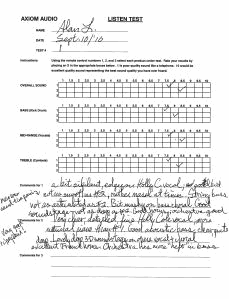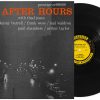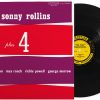As part of Axiom Audio’s 30th Anniversary celebration last month (September 2010), attended by a genial group of Axiom’s most enthusiastic customers, a day of double-blind listening tests was scheduled along with plant tours and seminars so that almost everyone could have a chance to experience what is regarded in knowledgeable circles as the only way to truly compare and rank loudspeakers for musical accuracy free of listener bias based on design, price, brand name, and physical appearance.
The double-blind test protocol (combined with precise anechoic on- and off-axis frequency response measurements) has formed the foundation of loudspeaker research and development in Canada for Axiom as well as several other prominent Canadian brands for several decades. Double-blind protocol is used in medical research and drug development as the only method of eliminating potential bias by researchers and test subjects alike.
After the double-blind sessions concluded, some participants remarked that they were sometimes confused by subtle differences in music reproduction, wondering what specifically to listen for and how to describe those differences. (All the listeners could use their own choice of music or CDs provided by Axiom, and could take as long as they wanted to do the comparison.)
I’ve been doing double-blind comparisons of loudspeakers for about 30 years now for the various magazines I wrote for and edited as well as for Axiom Audio. While my taste in music has changed little over the years, and I still prefer recordings of acoustical music—mainly jazz, vocal and orchestral music–rather than amplified instruments as source material, the qualities that distinguish a really excellent speaker from one ranked “good” or “mediocre” can still be heard using almost any well-recorded musical selection.
The question is: what to listen for, and how to describe it. Unless the differences are really blatant and obvious–a screechy aggressive treble or virtual absence of deep bass, for example–it’s a real test of listening skills to accurately characterize a loudspeaker’s accuracy in reproducing musical instruments and vocals.

In the interests of quantifying listening impressions, I thought that an analysis of my own rating form might be helpful not only to those Axiom fans who visited Axiom but to enthusiasts of every stripe. For those who can’t decipher my writing in the thumbnail scan of my rating form, I’ll explain my comments and numerical rankings of the two speakers under test. (Spoiler Alert! At the end of the day, Speaker #1 was revealed to be B&W’s pricey Nautilus 805, about $2,500 per pair at the time of purchase, and Speaker #2 was Axiom’s M3 v3, which sells for $348 per pair, including free shipping.)
Under “Overall Sound,” speaker #1 received a 7.5 out of a possible 10. A rating of 7.5 is what I’d call “good,” which means it’s a reasonably accurate, pleasant-sounding loudspeaker but with a couple of audible flaws that prevent it from getting a higher score. I gave speaker #2 a rating of 8.5; while not perfect, it represents a speaker that I’d describe as “excellent” with no blatant flaws or audible colorations.
Following “Overall Sound,” in the breakdown of bass, midrange and treble, the gap in numerical ranking remained consistent. While rating kick drum is useful with rock and pop music (I used a CD of Taj Mahal), I mainly use an orchestral CD with timpani and bass drums along with several jazz CDs with well-recorded acoustic string bass. Speaker #1’s string bass was “not as articulate” as #2, which means I could not follow the deepest bass tones as clearly on the B&W as I could on the Axiom M3. I had to strain to hear the plucked bass tones on the 805. On a big choral recording, I also couldn’t hear the men’s bass parts on speaker #1 (“mushy on bass choral”) as clearly as on #2. Later on, I noted that an orchestra has “more bass heft on speaker #2 than on #1.”
The Holly Cole jazz vocal of “I Can See Clearly Now (the Rain is Gone)” for me is very revealing of midrange vocal problems as well as having very natural piano and stand-up bass. On the B&W, I was unhappy with her voice, calling it “a bit sibilant and edgy”, even “rather nasal at times,” while on the Axiom M3, I was really pleased, noting how “natural” and “detailed” her vocal was. I also found the piano more natural than on the B&W. I really liked the stand-up bass on the Axiom, calling it “clear and quite deep”. The Axiom’s “3D soundstage” came in for special praise, where I noted it was “lovely and deep” on opera vocals and big choral selections. You can hear that depth on French horns on the Axiom M3 but not nearly as much on the B&W. I didn’t like the sound of timpani drums on the B&W, which sounded “narrow” and a bit squished (this follows the “mushy” comment I made about the male choral parts) whereas I noted the “very good timpani” on the Axiom M3.
Overall, I still liked the B&W on orchestral works with lots of horns, but I didn’t use adjectives like “excellent” and “lovely”. That’s because the French horn sound didn’t pervade the acoustic space and soundstage the way they did with the Axiom M3. I liked the cymbals on the B&W but I downgraded my rating to 7.5 because I felt they were a bit too extreme, too defined, whereas the Axiom had just the right amount of metallic shimmer without sounding exaggerated.
In the end, this was a really enlightening comparison, because it showed off what I’ve maintained for years: there is little or no correlation between musical accuracy and price. It was also not easy; isolating the differences between a “good” loudspeaker and an excellent one comes down to nuances, although the sibilance of the B&W on the Holly Cole vocals I view as a significant flaw that would show up on lots of recordings, hence my 7.5 rating. Any speaker with this tendency has a rougher midrange, which I noted: “good, but not as smooth as #2, rather nasal at times.”
Such double-blind comparisons as these between quite good and excellent speakers sometimes elicit a phrase, “similarly good,” which I borrowed from Dr. Floyd Toole many years ago, which he used when two speakers under test sound somewhat different, but each are essentially very pleasing and uncolored.
However in the B&W 805 vs. Axiom M3 listening test, I did not write “similarly good” because I clearly had a preference for one over the other and that was expressed in the individual scores and in my written comments. If, in any blind tests in the future, you find yourself undecided between two loudspeakers, sometimes preferring one speaker on some music and then the other speaker on other selections and ranking the two with the same scores, then you can confidently note that the two are “similarly good.”






























